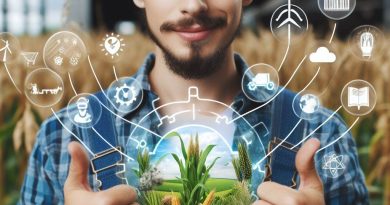Robotic Farmhands and Climate Adaptation
Last Updated on March 2, 2024
Introduction
Climate adaptation in farming is crucial.
Technology, like robotic farmhands, is vital for resilience, this post examines their benefits and challenges.
Farming faces increasing challenges due to climate change technology plays a pivotal role in addressing these challenges.
Robotic farmhands offer significant advantages, they can work tirelessly, regardless of weather conditions.
Moreover, they reduce dependency on manual labor this is particularly valuable in regions facing labor shortages.
Robotic farmhands also enhance efficiency they can perform tasks with precision, optimizing resource usage.
However, challenges exist in integrating these technologies, high initial costs can be prohibitive for small-scale farmers.
Moreover, maintenance and technical expertise are necessary. Not all farmers have access to these resources.
Despite challenges, the benefits of robotic farmhands are compelling. They contribute to climate adaptation by increasing productivity.
Furthermore, they can help mitigate the impacts of extreme weather events. Their reliability ensures consistent crop yields.
Therefore, robotic farmhands are instrumental in climate adaptation. This post will delve into their benefits and challenges.
Benefits of Robotic Farmhands in Climate Adaptation
Robotic farmhands have brought about numerous advantages in climate adaptation for farmers:
Increased efficiency and productivity
Robots are capable of working tirelessly and consistently, leading to improved efficiency and increased productivity on farms.
They can operate 24/7 without the need for breaks or rest, ensuring continuous work.
Reduction of labor costs
By substituting human labor with robotic farmhands, farmers can significantly reduce labor costs.
Robots do not require wages or benefits, and their maintenance costs are relatively low.
Improved accuracy in resource management
Robots utilize advanced sensors and technology to monitor crop conditions, soil moisture levels, and nutrient requirements in real-time.
This allows for precise and targeted resource management, optimizing crop growth and minimizing waste.
Ability to work in extreme weather conditions
Unlike human farm workers who may be limited by extreme weather events, robotic farmhands can withstand and operate efficiently in challenging climate conditions.
They are not affected by heat, cold, or heavy rainfall, ensuring consistent farm operations.
Examples of successful implementation in farms
Various farms worldwide have already integrated robotic farmhands into their operations, reaping the benefits of climate adaptation.
For instance, dairy farms have employed automated milking systems, improving milk production efficiency.
In strawberry farms, robots have been introduced to handle delicate harvesting operations, ensuring minimal damage to the fruit and increased overall productivity.
Vertical farming operations have also embraced robots to optimize space utilization, automate planting and harvesting, and monitor crop health, resulting in higher yields and controlled environmental conditions.
In fact, the utilization of robotic farmhands has proven to be advantageous for farmers in adapting to climate change.
Their ability to enhance efficiency, reduce labor costs, improve accuracy in resource management, withstand extreme weather conditions, and provide successful examples of implementation make them valuable assets in the agricultural industry.
Read: Farm Futures: Battling Climate & Floods
Challenges of Robotic Farmhands in Climate Adaptation
As the world faces the ever-increasing challenges of climate change, there is a growing need for technologies that can help farmers adapt to new environmental conditions.
Robotic farmhands have emerged as a potential solution to this problem, offering automated assistance in agricultural tasks.
However, these innovative machines bring their own set of challenges to the table:
High initial investment and maintenance costs
One of the primary challenges in adopting robotic farmhands for climate adaptation is the high upfront cost.
Purchasing and implementing such technology requires a significant financial investment that may be out of reach for many small-scale farmers.
Integration with existing farming systems
Integrating robotic farmhands into existing farming operations can present difficulties.
Farmers need to ensure that these machines can seamlessly fit into their established systems and workflows without disrupting productivity or causing conflicts.
Limited adaptability to complex tasks
While robotic farmhands excel at certain repetitive and simple tasks, they often struggle to perform more complex and nuanced agricultural activities.
This limited adaptability hinders their effectiveness in complete climate adaptation.
Risk of job displacement in rural communities
Introducing robotic farmhands into rural communities raises concerns about job displacement.
As these machines take over manual roles, there is a potential decline in employment opportunities for agricultural workers, affecting the livelihoods of many individuals.
Safety concerns and ethical considerations
Implementing robotic farmhands comes with safety concerns and ethical considerations.
Farmers must ensure that these machines are designed to operate safely around humans and are programmed to prioritize the well-being of both workers and animals.
In short, while robotic farmhands offer promising advantages in climate adaptation, they also present challenges that need to be addressed.
The high initial investment and maintenance costs, integration with existing farming systems, limited adaptability to complex tasks, risk of job displacement, and safety concerns are key factors that must be carefully considered.
Collaborative efforts between technology developers, agricultural experts, and policymakers are crucial in finding sustainable solutions that can maximize the benefits of robotic farmhands while minimizing the potential drawbacks.
Read: Climate Impact: Protecting Our Farms

Successful Case Studies of Robotic Farmhands in Climate Adaptation – Case study
Robotics technology for precision farming
Robotic farmhands have revolutionized the agricultural industry, especially in the face of climate change.
Precision farming, made possible by robotics technology, has facilitated significant improvements in crop yield and water conservation.
Through the use of advanced sensors and data analytics, these robotic systems can collect real-time information about soil conditions, climate patterns, and growth stages.
This data enables farmers to make informed decisions, optimizing irrigation and fertilization strategies.
By precisely adapting their farming practices, they can ensure optimal yield while minimizing resource waste.
Furthermore, the integration of robotics allows for more accurate and efficient application of pesticides and other agrochemicals.
By analyzing weather and climate data, these automated systems can determine the most suitable timing and dosage for different crops.
This not only reduces the environmental impact of farming but also ensures crop protection and resilience in the face of changing weather patterns.
Automated greenhouse systems
Greenhouse farming plays a crucial role in ensuring food security and climate adaptation.
Robotic farmhands have significantly improved the efficiency and effectiveness of greenhouse operations.
Automated systems monitor and control environmental parameters such as temperature, humidity, and CO2 levels, creating the ideal growing conditions for crops.
By maintaining precise and stable conditions, these robotic systems promote optimal growth and development, regardless of external climate fluctuations.
Additionally, greenhouse automation allows for the cultivation of crops that are not native to the region.
By creating a controlled environment, farmers can grow a diverse range of plants, expanding their product offerings and adapting to changing consumer demands.
This flexibility is particularly valuable in the face of unpredictable climate patterns that may render traditional farming methods less reliable.
Drone technology for crop monitoring
Drones equipped with advanced imaging and sensing technologies have revolutionized crop monitoring and management.
These aerial robots provide real-time data on the health and condition of crops, enabling farmers to respond quickly to potential threats.
By capturing high-resolution images and using algorithms to analyze plant vitality and growth patterns, drones can detect early signs of pest infestations or diseases.
Farmers can then take immediate action, implementing targeted interventions and preventing widespread crop damage.
This proactive approach minimizes the need for widespread pesticide use and reduces the overall ecological impact of farming practices.
Furthermore, drones enable farmers to monitor and assess the impact of climate-related risks such as drought or flooding.
By regularly surveying the fields from above, they can identify areas that require additional irrigation or drainage, ensuring efficient water management and adaptation to changing weather conditions.
In general, robotic farmhands have proven to be successful tools in climate adaptation within the agricultural sector.
Through precision farming, automated greenhouse systems, and drone technology, farmers can optimize resource utilization, enhance crop growth, and mitigate climate-related risks.
These case studies demonstrate the potential of robotics in transforming agriculture and ensuring food security in the face of a changing climate.
Read: Crops & Floods: Navigating the Risks
Learn More: Carbon Farming: Earth’s Ally
Future Prospects and Limitations
Potential Advancements in Robotic Farmhands
In the future, robotic farmhands have the potential to bring about significant advancements in agriculture.
Robots equipped with advanced sensors and computer vision systems can revolutionize the way farming tasks are performed.
These farmhands can autonomously plant and harvest crops, monitor crop health, and apply precise amounts of fertilizers and pesticides.
Integration with Artificial Intelligence and Machine Learning
One of the most significant prospects for robotic farmhands lies in their integration with artificial intelligence and machine learning.
By analyzing vast amounts of data, these robots can make informed decisions and adapt to changing environmental conditions.
This integration allows them to optimize farming practices, minimize resource wastage, and maximize crop yields.
Enhanced Adaptability and Versatility for Various Farming Tasks
Robotic farmhands have the potential to be incredibly adaptable and versatile in performing various farming tasks.
They can be equipped with different attachments and tools, enabling them to handle tasks such as plowing, weeding, and harvesting.
This versatility ensures that they can be utilized throughout the year for different crops and farming practices.
Key Limitations and Areas for Improvement
However, despite their potential, robotic farmhands still face some limitations and areas for improvement.
One major limitation is their inability to handle complex or delicate tasks that require human dexterity and intuition.
Additionally, there are challenges with navigating uneven terrains and unpredictable weather conditions.
Improvements in these areas are essential for the widespread and successful implementation of robotic farmhands.
Collaboration with Farmers and Stakeholders for Sustainable Implementation
To overcome these limitations and ensure the sustainable implementation of robotic farmhands, collaboration with farmers and stakeholders is crucial.
By involving farmers in the development process, their expertise and insights can be incorporated into the design and functionality of these robots.
Engaging stakeholders, such as agricultural organizations and policymakers, can also help address regulatory and ethical concerns.
Furthermore, fostering partnerships with technology companies can accelerate research and development efforts in this field.
In closing, the future prospects for robotic farmhands are promising, with potential advancements that can revolutionize agriculture.
Integration with artificial intelligence and machine learning, enhanced adaptability, and collaboration with farmers and stakeholders are essential for their success.
However, it is crucial to acknowledge their limitations and actively work towards improving them for widespread implementation.
Read: Changing Seasons, Changing Harvests: US Focus
Delve into the Subject: Solar Tech in Modern Agriculture
Conclusion
Robotic farmhands have demonstrated numerous benefits in climate adaptation for agriculture.
They efficiently perform repetitive tasks, reduce labor costs, and enhance productivity in adverse climatic conditions.
However, there are several challenges that need to be addressed, such as high initial investment, limited adaptability to complex tasks, and potential job displacement.
Despite these challenges, the importance of technological innovation in farming cannot be overstated.
Robotic farmhands represent a significant step towards achieving climate resilience in agriculture.
Technological advancements have the potential to transform the agricultural industry, enabling it to overcome the challenges posed by climate change.
Innovation in robotics can revolutionize the way farming is conducted, ensuring higher yields, efficient resource utilization, and reduced environmental impact.
By embracing the potential of robotic farmhands, agriculture can mitigate the effects of climate change, promote sustainable practices, and secure food production for future generations.
It is essential for farmers, researchers, and policymakers to continue investing in technological advancements to enhance the capabilities and reliability of robotic farmhands.
Ultimately, the integration of robotics and automation in farming holds tremendous promise for the future, enabling agriculture to adapt and thrive in an increasingly challenging climate.


